Cloud computing and emerging IT platforms Vision hype and reality for delivering computing as the 5t
- 格式:pdf
- 大小:386.13 KB
- 文档页数:62
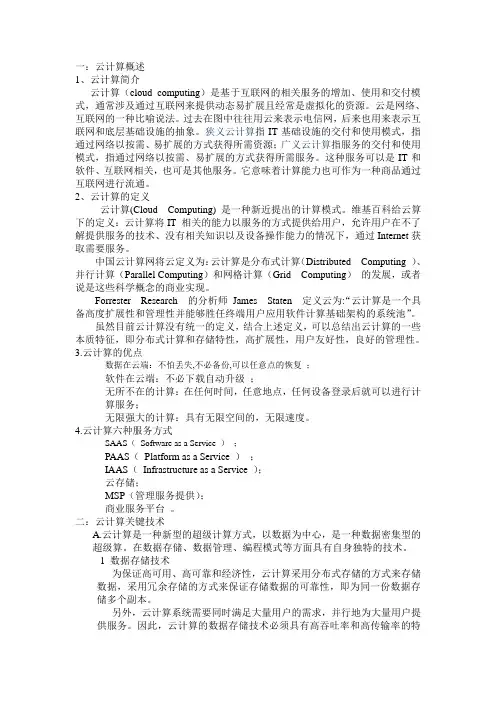
一:云计算概述1、云计算简介云计算(cloud computing)是基于互联网的相关服务的增加、使用和交付模式,通常涉及通过互联网来提供动态易扩展且经常是虚拟化的资源。
云是网络、互联网的一种比喻说法。
过去在图中往往用云来表示电信网,后来也用来表示互联网和底层基础设施的抽象。
狭义云计算指IT基础设施的交付和使用模式,指通过网络以按需、易扩展的方式获得所需资源;广义云计算指服务的交付和使用模式,指通过网络以按需、易扩展的方式获得所需服务。
这种服务可以是IT和软件、互联网相关,也可是其他服务。
它意味着计算能力也可作为一种商品通过互联网进行流通。
2、云计算的定义云计算(Cloud Computing) 是一种新近提出的计算模式。
维基百科给云算下的定义:云计算将IT 相关的能力以服务的方式提供给用户,允许用户在不了解提供服务的技术、没有相关知识以及设备操作能力的情况下,通过Internet获取需要服务。
中国云计算网将云定义为:云计算是分布式计算(Distributed Computing )、并行计算(Parallel Computing)和网格计算(Grid Computing)的发展,或者说是这些科学概念的商业实现。
Forrester Research 的分析师James Staten 定义云为:“云计算是一个具备高度扩展性和管理性并能够胜任终端用户应用软件计算基础架构的系统池”。
虽然目前云计算没有统一的定义,结合上述定义,可以总结出云计算的一些本质特征,即分布式计算和存储特性,高扩展性,用户友好性,良好的管理性。
3.云计算的优点数据在云端:不怕丢失,不必备份,可以任意点的恢复;软件在云端:不必下载自动升级;无所不在的计算:在任何时间,任意地点,任何设备登录后就可以进行计算服务;无限强大的计算:具有无限空间的,无限速度。
4.云计算六种服务方式SAAS(Software as a Service );PAAS(Platform as a Service );IAAS(Infrastructure as a Service );云存储;MSP(管理服务提供);商业服务平台。
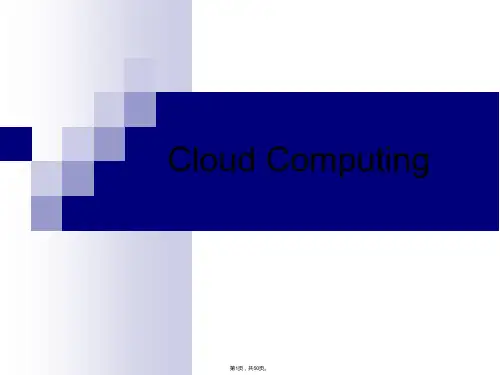
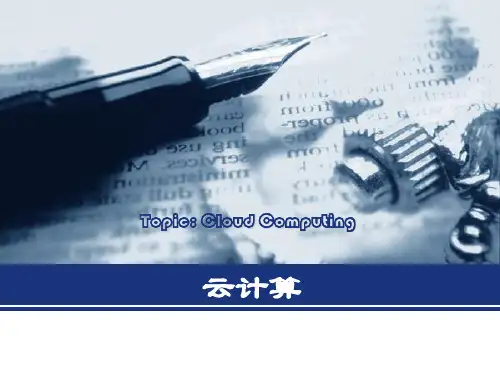
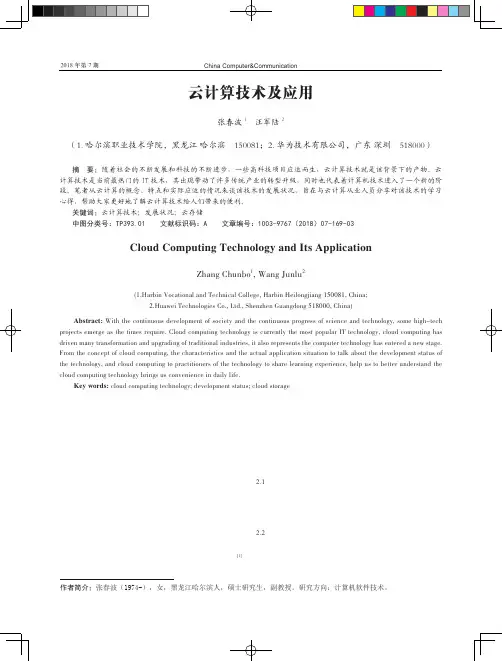
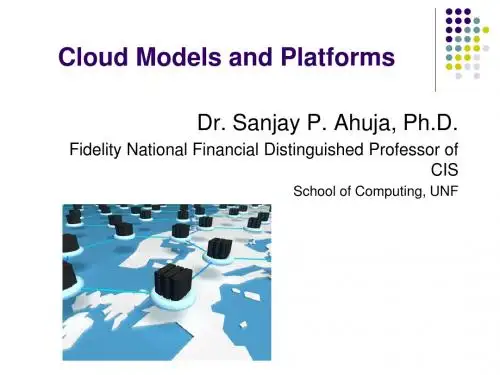
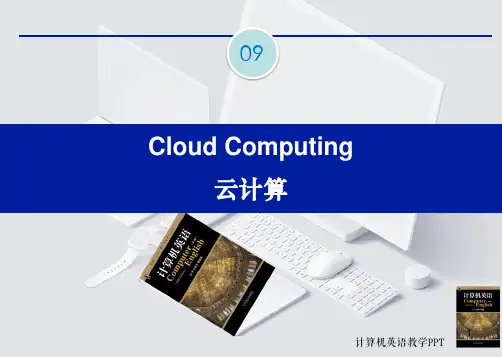
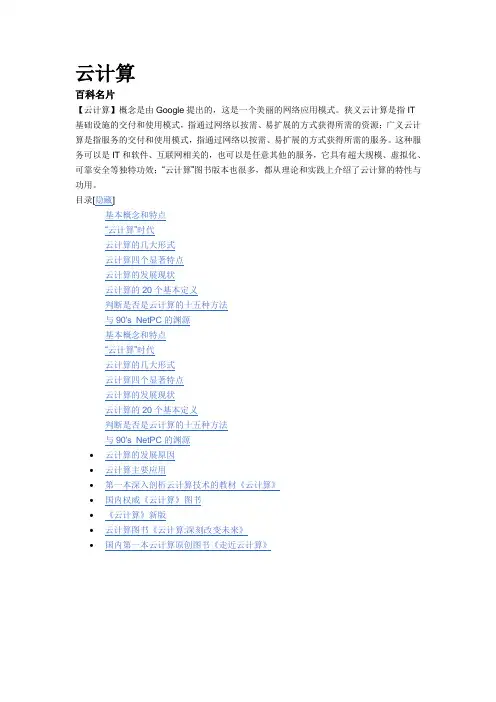
云计算百科名片【云计算】概念是由Google提出的,这是一个美丽的网络应用模式。
狭义云计算是指IT基础设施的交付和使用模式,指通过网络以按需、易扩展的方式获得所需的资源;广义云计算是指服务的交付和使用模式,指通过网络以按需、易扩展的方式获得所需的服务。
这种服务可以是IT和软件、互联网相关的,也可以是任意其他的服务,它具有超大规模、虚拟化、可靠安全等独特功效;“云计算”图书版本也很多,都从理论和实践上介绍了云计算的特性与功用。
目录[隐藏]基本概念和特点“云计算”时代云计算的几大形式云计算四个显著特点云计算的发展现状云计算的20个基本定义判断是否是云计算的十五种方法与90's NetPC的渊源基本概念和特点“云计算”时代云计算的几大形式云计算四个显著特点云计算的发展现状云计算的20个基本定义判断是否是云计算的十五种方法与90's NetPC的渊源•云计算的发展原因•云计算主要应用•第一本深入剖析云计算技术的教材《云计算》•国内权威《云计算》图书•《云计算》新版•云计算图书《云计算:深刻改变未来》•国内第一本云计算原创图书《走近云计算》[编辑本段]基本概念和特点英译:cloud;cloud computing;cloud computer;cloud-based。
云计算(cloud computing,分布式计算技术的一种,其最基本的概念,是透过网络将庞大的计算处理程序自动分拆成无数个较小的子程序,再交由多部服务器所组成的庞大系统经搜寻、计算分析之后将处理结果回传给用户。
透过这项技术,网络服务提供者可以在数秒之内,达成处理数以千万计甚至亿计的信息,达到和“超级计算机”同样强大效能的网络服务。
最简单的云计算技术在网络服务中已经随处可见,例如搜寻引擎、网络信箱等,使用者只要输入简单指令即能得到大量信息。
未来如手机、GPS等行动装置都可以透过云计算技术,发展出更多的应用服务。
进一步的云计算不仅只做资料搜寻、分析的功能,未来如分析DNA结构、基因图谱定序、解析癌症细胞等,都可以透过这项技术轻易达成[7]。
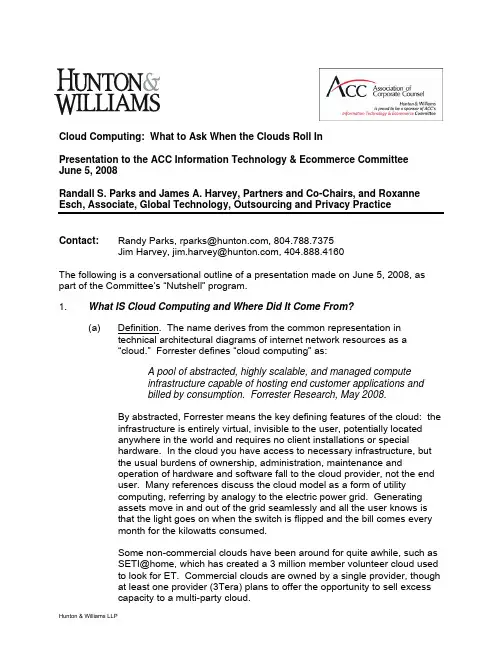
Cloud Computing: What to Ask When the Clouds Roll InPresentation to the ACC Information Technology & Ecommerce CommitteeJune 5, 2008Randall S. Parks and James A. Harvey, Partners and Co-Chairs, and Roxanne Esch, Associate, Global Technology, Outsourcing and Privacy Practice Contact: Randy Parks, rparks@, 804.788.7375Jim Harvey, jim.harvey@, 404.888.4160The following is a conversational outline of a presentation made on June 5, 2008, as part of the Committee’s “Nutshell” program.1. What IS Cloud Computing and Where Did It Come From?(a) Definition. The name derives from the common representation intechnical architectural diagrams of internet network resources as a“cloud.” Forrester defines “cloud computing” as:A pool of abstracted, highly scalable, and managed computeinfrastructure capable of hosting end customer applications andbilled by consumption. Forrester Research, May 2008.By abstracted, Forrester means the key defining features of the cloud: theinfrastructure is entirely virtual, invisible to the user, potentially locatedanywhere in the world and requires no client installations or specialhardware. In the cloud you have access to necessary infrastructure, butthe usual burdens of ownership, administration, maintenance andoperation of hardware and software fall to the cloud provider, not the enduser. Many references discuss the cloud model as a form of utilitycomputing, referring by analogy to the electric power grid. Generatingassets move in and out of the grid seamlessly and all the user knows isthat the light goes on when the switch is flipped and the bill comes everymonth for the kilowatts consumed.Some non-commercial clouds have been around for quite awhile, such asSETI@home, which has created a 3 million member volunteer cloud usedto look for ET. Commercial clouds are owned by a single provider, thoughat least one provider (3Tera) plans to offer the opportunity to sell excesscapacity to a multi-party cloud.(b) Evolution. The term “cloud computing” is only a few years old. Keyenablers of the phenomenon have been:(i) High bandwidth, low cost network capacity. The cloud depends onhigh throughput, reliable networks to enable remote computing andstorage.(ii) Open standards and open source software. The cloud depends on highly flexible, low cost standard architectures to enablevirtualization of infrastructure. Most clouds are reported to runLinux. Also, the cloud is most economically efficient when softwarecosts are low or non-existent and there are no licensing restrictions.(iii) Virtualization software and techniques. The cloud not only depends upon, but is defined by the ability to create virtual machines forevery user.(iv) User acceptance of remote computing models. Years of usingHotmail has trained a generation that a important applicationneedn’t be hosted on your own machines or maintained by yourown staff. SaaS evolution has brought us a step closer, as well.2. Implications of the CloudCloud computing may be the disruptive technology of the next decade, as enterprises follow individuals and small-business into the cloud. Players which have an interest in maintaining proprietary software sales may find their market share eroded. 3. Who Are the Players and What are They Offering?Key players include web moguls, technology-based start-ups and the massively multinational:(a) Amazon, clams 300,000 developers working with its “Elastic ComputeCloud” (EC2), “Simple Storage Solutions” (S3), Amazon Simple DB andother web services since 2002.(b) GoogleApps - claims to be signing up 3,000 businesses each day.Offering cloud solutions in partnership with SalesForce and IBM.(c) ’s , 3Tera’s Cloudware, Rackspace’s Mozzoand many, many others.(d) The big boys: Microsoft Windows Live, IBM Blue Cloud, IBM/Google“Blue Business Platform,” Oracle Grid, Sun Hydrazine and more. Playerswith massive infrastructures and marketing plans - and varying historiesand agendas.4. 10 Questions to Ask About the CloudIf you ask and answer these questions you’ll have covered most of the legalissues associated with the cloud. I’ll use Amazon’s Web Services Agreement as an example of how some of these issues are treated by a major commodity cloud provider. Less commoditized solutions are available and some negotiation ofterms may be possible, though pricing models widely offered today don’t allow for much customization.(a) What’s going into the cloud? Analysis of the legal issues depends on theanswers to these threshold questions:applications?(i) What(ii) Whatdata?With that information in hand, the follow up questions might include:(b) Do my application licenses permit hosting in the cloud? Do applicablelaws permit hosting of the application in the cloud (ITAR? ExportAdministration Regulations (EAR)?)?(c) Do applicable laws permit hosting of the target data in the cloud? Someproviders explicitly state that there is no guarantee which data center willhouse your data. Amazon’s new “Availability Zones” may give you somecontrol over this issue.(d) Do other data-related obligations permit hosting in the cloud? Consider,among others:(i) contractual obligations to customers;policies;(ii) privacy(iii) interaction with the need for e-discovery.(e) What service levels are necessary and are they available? For example,what level of application availability is required and can the providerdeliver? Amazon offers no SLAs and, in fact, notes that downtime ispossible and disclaims all remedies. Another major provider offers anemail availability SLA, though the related credit is additional days ofservice which must be specifically requested.(f) What security commitments are necessary and are they available? Forexample, must the infrastructure meet the PCI Data Security Standard?How do you perform the penetration testing and quarterly scans that theDSS requires? Amazon disclaims all responsibility for security, reservesthe right to disclose your data in response to a simple “request” of agovernmental body and to demand copies of applications for purposes ofverifying compliance.(g) Can you audit billing? Will the provider support such an audit? Is thatnecessary for chargeback or internal control purposes?(h) “What Happens if They Lose Your Stuff?” When I explained thispresentation to my 14 year old daughter, her first question was “Whathappens if they lose your stuff?” Well, what does happen if they lose yourstuff? What’s the risk of that happening (and are you sure you really knowthe answer to that question)? Do you need explicit disaster recoveryrequirements or special support to configure redundancy? Amazondisclaims any responsibility for loss of data or security breach, but offerstools to create redundancy.(i) How do you exit and transition? How easily is data recovered andtransmitted? Amazon will store data for retrieval for only 30 days andretrieval is conditioned on payment of all fees and compliance with otherundefined terms they may specify. If you are terminated for cause, yourdata may not be available. Assurances of post-termination assistance arethin, at best.(j) Will the provider and the service be there tomorrow? Disruptivetechnologies attract players who may not be around for the long term -- oreven the short term. Even the largest players hedge their bets: Amazon’sWeb Services Customer Agreement permits termination of paid serviceson 60 days notice and change of terms of use on 15 days notice. Freeservices can be terminated or changed with no notice. Other providersreserve the right to terminate services at any time.5. What Is it Good For?(a) Joint ventures and short-term projects that need to stand-up quickly, buthave significant computing needs which can’t wait for internal resourcesand where third-party pricing of those services is necessary to avoidconflict over charge-back models.(b) Simple applications without need for active monitoring or management.(c) Small business and any other business than can tolerate commodityservice in exchange for the accessing high-quality shared infrastructure.6. What Isn’t It Good For?(a) Storage and processing of personal / sensitive information, at least notwithout careful diligence as to the types of data and how they will betreated.(b) Complex applications which require active monitoring and support.(c) Organizations not comfortable with self-service.7. How Does the Enterprise Respond to the Cloud?(a) Review current policies for coverage. Many of the issues presented mayalready be addressed. If not, get ahead of the issue and develop a policyaddressing use of cloud-based services based on your unique risk profile.Consider building a questionnaire to collect necessary data from businessunits testing the cloud.(b) Investigate whether cloud computing already is in-use in the organization,perhaps as part of a rogue deployment. You may be surprised. Clouduse is particularly easy to accomplish outside the usual vetting process,since its cheap and can be deployed with a credit card and withoutengaging IT. Consider whether these deployments should continue or belimited, based upon established risk guidelines.。


云计算的概念云计算(cloudcomputing)是一种基于因特网的超级计算模式,在远程的数据中心里,成千上万台电脑和服务器连接成一片电脑云。
因此,云计算甚至可以让你体验每秒10万亿次的运算能力,拥有这么强大的计算能力可以模拟核爆炸、预测气候变化和市场发展趋势。
用户通过电脑、笔记本、手机等方式接入数据中心,按自己的需求进行运算。
狭义的云计算是指IT基础设施的交付和使用模式,指通过网络以按需、易扩展的方式获得所需的资源(硬件、平台、软件)。
提供资源的网络被称为“云”。
“云”中的资源在使用者看来是可以无限扩展的,并且可以随时获取,按需使用,随时扩展,按使用付费。
这种特性经常被称为像水电一样使用IT基础设施。
广义的云计算是指服务的交付和使用模式,指通过网络以按需、易扩展的方式获得所需的服务。
这种服务可以是IT和软件、互联网相关的,也可以是任意其他的服务。
云计算的概念是由谁提出的_云计算的云是什么意思云计算原理通过使计算分布在大量的分布式计算机上,而非本地计算机或远程服务器中,企业数据中心的运行将更与互联网相似。
这使得企业能够将资源切换到需要的应用上,根据需求访问计算机和存储系统。
云计算特点①超大规模“云计算”具有相当大的规模,这一点在各个云计算巨头身上便可以提现。
比如:Google、亚马逊、IBM、微软等“云计算”巨头均拥有几十万台服务器来支撑云计算的发展。
②虚拟化“云计算”可以使用户在任意时间、位置来获取服务。
云计算并不是固定的有形实体。
在日常生活中,我们只需一个手机,便可以通过网络服务来获取我们需要的一切。
③高可用“云计算”使用了数据多副本容错、计算节点同构可互换等措施来保障服务的高可靠用性,这一点比我们使用本地计算机要靠谱的多。
④通用性在“云计算”的支撑下,可以构造出数以万计的应用,同一个“云”可以同时支撑不同的应用运行,并不针对某一种应用。
⑤弹性扩展“云计算”其中一个显著特点便是可以动态伸缩,来满足应用和客户规模增长的需要。
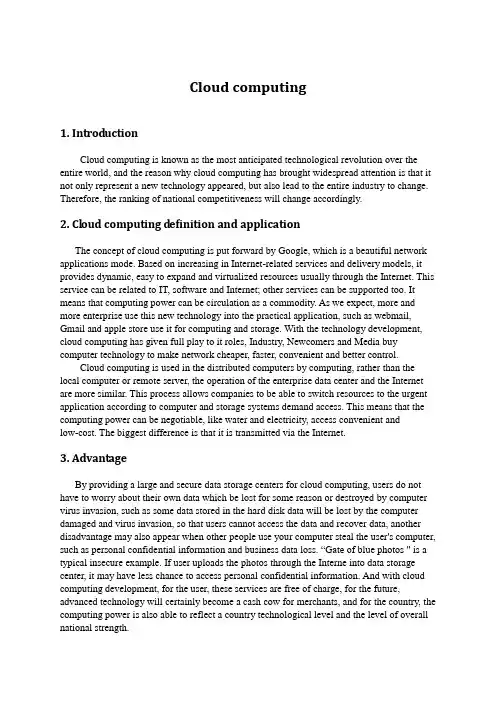
Cloud computing1. IntroductionCloud computing is known as the most anticipated technological revolution over the entire world, and the reason why cloud computing has brought widespread attention is that it not only represent a new technology appeared, but also lead to the entire industry to change. Therefore, the ranking of national competitiveness will change accordingly.2. Cloud computing definition and applicationThe concept of cloud computing is put forward by Google, which is a beautiful network applications mode. Based on increasing in Internet-related services and delivery models, it provides dynamic, easy to expand and virtualized resources usually through the Internet. This service can be related to IT, software and Internet; other services can be supported too. It means that computing power can be circulation as a commodity. As we expect, more and more enterprise use this new technology into the practical application, such as webmail, Gmail and apple store use it for computing and storage. With the technology development, cloud computing has given full play to it roles, Industry, Newcomers and Media buy computer technology to make network cheaper, faster, convenient and better control.Cloud computing is used in the distributed computers by computing, rather than the local computer or remote server, the operation of the enterprise data center and the Internet are more similar. This process allows companies to be able to switch resources to the urgent application according to computer and storage systems demand access. This means that the computing power can be negotiable, like water and electricity, access convenient andlow-cost. The biggest difference is that it is transmitted via the Internet.3. AdvantageBy providing a large and secure data storage centers for cloud computing, users do not have to worry about their own data which be lost for some reason or destroyed by computer virus invasion, such as some data stored in the hard disk data will be lost by the computer damaged and virus invasion, so that users cannot access the data and recover data, another disadvantage may also appear when other people use your computer steal the user's computer, such as personal confidential information and business data loss. “Gate of blue photos " is a typical insecure example. If user uploads the photos through the Interne into data storage center, it may have less chance to access personal confidential information. And with cloud computing development, for the user, these services are free of charge, for the future, advanced technology will certainly become a cash cow for merchants, and for the country, the computing power is also able to reflect a country technological level and the level of overall national strength.As the user data stored in the cloud storage center, can reduce customer demand for the hardware level, coupled with cloud computing extremely powerful computing capability, it can enable users to call data more convenient and quick if can add the high-speed networks. Users no longer need replace the computer caused by having no enough hard disk space and CPU computing power. Otherwise, users only surf the Internet to access cloud storage center and then easily access the data.As powerful data storage centers, the most wonderful features is sharing data. No matter computer data or a variety of communication devices such as mobile phones and PDA. When some damaged appeared in your phone, lost or replaced in order to chase the trend of the times and phone, data copy is a tedious thing. However, in another way, you can solve the entire problem through cloud storage center.Cloud computing services will create more millions of jobs. On March 6, a news show that show that Microsoft statement a commissioned research conducted by theworld-renowned market analyst firm IDC. The research show that cloud computing will create nearly 14 million new jobs worldwide in 2015. And also predicted that it can stimulate IT innovation and brought the new revenue which can reach about $ 1.1 trillion, coupled with cloud computing efficiency substantially promote, the organization will increasere-investment and work opportunity. IDC chief research officer , as senior vice president, John F. Gantz said: "For most organizations, there is no doubt that cloud computing will significantly enhance the return on investment and flexibility, reduce investment costs, and bring revenue growth multiplied as well, we usually believe that cloud computing will reduce jobs by mistake, the opposite, it can create a lot of jobs around the world, no matter emerging market, small cities and small businesses will increase employment opportunities and get benefit from cloud computing. "14. DisadvantageWith large storage center, cloud computing strongly urges powerful hardware conditions and safety measures, which including a large storage space and powerful computing capabilities. As today's scientific and technological rapid develop, user increased, hardware capabilities become one of the necessary condition for development, moreover, the cloud should be kept to enhance their computing power and storage space, and endless. Security measures also include two aspects; firstly, it is necessary to ensure that user data not damaged, lost, and stolen by others, which requires a strong IT team to full range of maintenance and strict access management strategies. Some information has been confirmed, the existing cloud computing service provider still cannot guarantee no similar problem occurs. For users, this is a very serious problem. Another security issue is a natural or unnatural disaster, also can cause the storage center damaged, can cause users cannot access.Cloud computing services are available via the Internet, therefore, user usually have high demands for network access speed, although domestic access speeds improve fast, but compared with LAN, it will appear delays, incomparable, In addition, no network, the user will not be able to access cloud services.The rapid rise of Cloud technology, in another perspective, also restricts the speed of1Reference[1]development, which also lead to lower demand for high-end devices. It is the basic reason why can restrict terminal development. Customer needs, determine the business requirements for products, if customers reduce the terminal's hardware and software requirements, the business will be greatly reduced the degree of product development and restricted the pace of the terminal technology development.5. Cloud computing devel opment in chinaIn China, Cloud computing services have been in a state of rapid development. Looking at the cloud computing industry, government accounted for a major position, and in the market they have also been given the affirmation of the cloud computing. The cloud computing services major support for government agencies and enterprises, therefore, the personal cloud computing services in China is a potential big cake and wait for people enjoying. However because of the domestic personal network speed upgrade too slow, and relevant government network supervision, the development of personal cloud computing services will have more difficult. Due to excessive speculation in the international aspects, in our country, a lot of companies want to get some benefit from the rapid development of technology, exploit cloud computing services projects and promote enterprise development. My personal view is that enterprises should do some preparation, judge it’s good or bad and prospects, as well as estimate the strength of the company and do their best. Through access to information discovery, cloud computing as a technology trend has been got the world's attention, but look at the forefront of foreign enterprise closely, we can easily find almost no companies start the business rely on cloud computing; cloud computing applications and related research are also mostly implement by those large enterprise with more funds. As the prospects for development, for the enterprise, profit is the most critical issues.Although cloud computing has been integrated into our lives, but the domestic development of cloud computing is still confronted with many problems, such as lack of user awareness, migration risk, lack of standards, user locks, security and data privacy, safety, standards, data privacy has become a topic of which we are most concerned.Nowadays, people still lack of comprehensive, systematic cognitive of Cloud computing, part of them just imitate completely others and foreign experience, ignoring the specific conditions in our country, resulting in spending much money, but failed to alleviate the complex IT issues. In the original data center, hardware is relatively independent, but migrates to cloud computing data center, systematic assessment and scientific analysis must be essential.Otherwise it may lead to the hardware platform not achieve the proper effect and even the collapse of the application system. Cloud computing products is quite diversity, but the birth of the cloud standard is extremely difficult, the major manufacturers just have their own standards, the Government is also involved, both of them are striving to be able to dominate the major position, so more efforts are still needed. The other faced challenge is how to provide users legitimate services is also very important, except the risks in the systems. Compared with traditional data centers, it cloud provided more services diversity, which also bring more difficult to control. Therefore, analyze the needs of users, reasonable, enforceable service level agreements (SLAs) provided will help users establish confidence in cloud computing services in a large extent. Security problems can be said that a key factor in cloud computinglanding. Amazon failure made people deep in thought, which is just one factor of the security. The other security risks include user privacy protection, data sovereignty, disaster recovery, and even illegal interests caused by some hackers. In the era of cloud computing, there will be more user privacy data placed in the clouds, more data, and more value. Most importantly, lack of user’s trust will lead to cloud computing landing.Although the development road is very far away, but the Government has been giving support and encouragement. In 2012 Cloud Computing Industry Development Forum was successfully held, which is strong evidence. At the meeting, as a CCID Consulting, cloud industry observers, as well as excellence forerunner of the cloud computing industry, Microsoft, with their co-operation, complete the first "China Cloud economic development Report”, which shows that in-depth interpretation the content of cloud formation and specify the key factor of economic development in the cloud. The result obtained based on thelong-term observation and in-depth research on cloud computing industry. In addition, the participants share their own point about industry environment, market situation, technology development, application service elements and so on; they also can come up with any question about the cloud computing, expects will do their best to give analysis and authoritative view.26. Future prospectsAbout cloud computing services future prospects, in my opinion, it will have great potential, we can find out the answer from the action of the giants of the major IT companies, but now it still in a state of excessive speculation. Many small companies have no any knowledge and experience about it, and still want to exploit the services project. I don’t think it is a sagacious decision. in fact, for current state, I maintained a cautious attitude, as a corporate without strong financial strength, I think they should focus on business development and growth, in order to reduce unnecessary waste of resources, they can develop and use it when the technology get mature stage.Finally, have to say that the future of the cloud computing, it not only can provide unlimited possibilities for storage, read, and manage data using the network. But also provides us infinite computing power because of its huge storage space, there is no powerful computing capabilities, it cannot provide users with easy and fast. In one word, the development potential of cloud computing is endless.7. Reference[1] Microsoft news, Cloud computing services will create more millions of jobs.2012-03-06[2] CCIDNET news, Cloud Computing Industry Development Forum was successfully. 2012-03-072Reference[2]。
第32卷第7期通信学报V ol.32No.7 2011年7月Journal on Communications July 2011云计算:体系架构与关键技术罗军舟,金嘉晖,宋爱波,东方(东南大学计算机科学与工程学院,江苏南京 211189)摘 要:系统地分析和总结云计算的研究现状,划分云计算体系架构为核心服务、服务管理、用户访问接口等3个层次。
围绕低成本、高可靠、高可用、规模可伸缩等研究目标,深入全面地介绍了云计算的关键技术及最新研究进展。
在云计算基础设施方面,介绍了云计算数据中心设计与管理及资源虚拟化技术;在大规模数据处理方面,分析了海量数据处理平台及其资源管理与调度技术;在云计算服务保障方面,讨论了服务质量保证和安全与隐私保护技术。
针对新型的云计算应用和云计算存在的局限性,又探讨并展望了今后的研究方向。
最后,介绍了东南大学云计算平台以及云计算研究与应用方面的相关成果。
关键词:云计算;虚拟化;数据中心;海量数据处理;服务质量;安全与隐私中图分类号:TP393文献标识码:A文章编号:1000-436X(2011)07-0003-19 Cloud computing: architecture and key technologiesLUO Jun-zhou, JIN Jia-hui, SONG Ai-bo, DONG Fang(School of Computer Science and Engineering, Southeast University, Nanjing 211189, China)Abstract: Based on the analysis and summary of the previous work, the cloud computing framework can be divided into three layers: core cloud services, cloud service management and user access interface. To realize low-cost, reliable, available and scalable cloud services, the up-to-date key technologies and research progresses of the three layers within the cloud framework are reviewed intensively and extensively. Regarding cloud infrastructure, the strategies for data cen-ter design and management are introduced together with the virtualization technology. In respect of large-scale data proc-essing, several platforms and their resource management and task scheduling mechanisms are investigated extensively.With regard to cloud service quality, both QoS guarantee and security/privacy protection are discussed in depth. The prospects for future research are further explored based on the new application models and limitations of cloud comput-ing. Finally, the cloud computing platform and research work of Southeast University are introduced.Key words: cloud computing; virtualization; data center; large-scale data processing; quality of service; security and privacy收稿日期:2011-05-20;修回日期:2011-06-30基金项目:国家自然科学基金资助项目(61070161,61070158,61003257, 60773103, 90912002);国家重点基础研究发展计划(“973”计划)基金资助项目(2010CB328104);国家科技支撑计划课题基金资助项目(2010BAI88B03);教育部博士点基金课题基金资助项目(200802860031);江苏省自然科学基金资助项目(BK2008030);国家科技重大专项课题基金资助项目(2009ZX03004-004-04);江苏省“网络与信息安全”重点实验室基金资助项目(BM2003201);“计算机网络与信息集成”教育部重点实验室项目(93K-9)Foundation Items: The National Natural Science Foundation of China(61070161, 61070158, 61003257, 60773103, 90912002); The National Key Basic Research Program of China (973 Program)(2010CB328104);China National Key Technology R&D Program (2010BAI88B03);China Specialized Research Fund for the Doctoral Program of Higher Education (200802860031); The Natural Science Foundation of Jiangsu Province (BK2008030); China National S&T Major Project (2009ZX03004-004-04); Jiangsu Provin-cial Key Laboratory of Network and Information Security (BM2003201); The Key Laboratory of Computer Network and Informa-tion Integration of Ministry of Education of China (93K-9)·4·通信学报第32卷1引言近年来,社交网络、电子商务、数字城市、在线视频等新一代大规模互联网应用发展迅猛。
信息技术云计算概览与词汇信息技术在当今社会中的重要性越来越显著,而云计算作为信息技术的重要组成部分之一,在各个行业中得到了广泛的应用。
本文将对云计算进行概览,并介绍与云计算相关的一些关键词汇,旨在为读者提供一个生动、全面、有指导意义的了解云计算的文章。
云计算,英文名为Cloud Computing,是一种运用互联网的方式来提供可随时、随地访问和使用的共享计算资源的方法。
云计算可以被分为公有云、私有云和混合云等模式。
公有云是由云服务提供商提供给多个客户使用的云计算资源,而私有云是被单个组织或企业所使用的云计算资源。
混合云则是将公有云和私有云相结合,以满足不同组织的需求。
云计算的核心优势之一是灵活性。
通过云计算,用户可以根据自身需求,随时调整计算资源的规模。
这种弹性使得企业能够更好地应对突发需求,同时也能够更好地管理资源成本。
此外,云计算还能够提供高可用性和可靠性的服务。
云计算提供商通常会在多个地理位置建立数据中心,以确保数据的备份和容灾。
这样一来,即使某个数据中心出现故障,用户的数据也能够在其他数据中心中得到保护。
与云计算相关的一些重要概念还包括虚拟化、容器化和可扩展性。
虚拟化是指将硬件资源进行抽象,划分为多个虚拟实例来运行不同的应用。
通过虚拟化,用户可以最大限度地利用硬件资源,提高资源利用率。
容器化则是在操作系统级别对应用进行隔离,实现不同应用之间的资源共享和独立运行。
容器化能够提供更高的应用性能和更快的部署速度。
可扩展性则是指云计算能够根据需要随时增加或减少计算资源的能力。
这种灵活性使得用户能够根据实际情况调整资源使用量,提高资源利用效率。
云计算在各个行业中都有广泛的应用。
在企业级应用中,云计算可以提供各种软件服务,如软件即服务(SaaS)、平台即服务(PaaS)和基础设施即服务(IaaS)。
这些服务能够帮助企业将关注点从基础设施管理转移到业务创新和用户体验上。
在教育领域,云计算可以帮助学校和教育机构提供在线学习平台、学生管理系统等服务。
Cloud ComputingCloud computing is a service provided by way of a dynamic scalable virtualized computing model resources over the Internet. This mode offers available , convenient , on-demand network access into a shared pool of computing resources can be configured ( resources, including networks, servers, storage , applications, services ) , these resources can be quickly provided , just put it less administration , or with service providers rarely interact .It is calculated by the distribution of the large number of distributed computers, rather than the local computer or a remote server, running enterprise data centers and the Internet will be more similar. This allows companies to switch to the application of the resources required , according to demand access to a computer and storage systems. Like a single generator from the old model to a centralized power plant model . It means that computing power can also be used as a tradable commodity , like gas, water and electricity , as access to convenient , inexpensive. The biggest difference is that it is transmitted through the Internet.Cloud computing service characteristics and nature of clouds, water circulation on the Internet has a certainsimilarity , so the cloud is a very apt analogy.Cloud computing proposed for the development of computers played a role in making the network more widely based . In my opinion cloud computing has four significant advantages : Cloud computing provides the most reliable and secure data storage center , users do not have to worry about data loss, virus attacks and other problems ; cloud computing client devices require a minimum , is also the most convenience ; cloud computing data and applications can be easily shared between different devices ; cloud computing as we use the network provides almost infinite number of possibilities.But on the other hand there are also disadvantages two aspects : first, it is safe , because the cloud computing power and data in the cloud , how to ensure the security of customer data is a relatively important . Security has two aspects, one is the data is not lost , the general service providers will have the ability to solve backup , but also occurs occasionally lost ; Another is that your data will not leak , although this will take some measures to service providers , not to outsiders , such as hacker attacks to get data , but the problem is the service provider 's internal staff is great . The second is the network delay or interruption. Cloud computing generally remoteaccess via the network, although it is now improving speed quickly, and LAN but compared to the speed or delays , and if once a network outage , the service will not be able to access .云计算云计算是一种通过Internet以办事的方式提供动态可伸缩的虚拟化的资源的计算模式。
对比
云计算常与网格计算(分布式计算的一种,由一群松散耦合的计算机集组成的一个超级虚拟计算机,常用来执行大型任务)、效用计算(IT资源的一种打包和计费方式,比如按照计算、存储分别计量费用,像传统的电力等公共设施一样)、自主计算(具有自我管理功能的计算机系统)相混淆。
事实上,许多云计算部署依赖于计算机集群(但与网格的组成、体系机构、目的、工作方式大相径庭),也吸收了自主计算和效用计算的特点。
它从硬件结构上是一种多对一的结构,从服务的角度或从功能的角度它是一对多的. (1)例如,今天要设计一供应链管理系统,可以先从市面上提供的免费云服务器主机,将Application放置主机上,使用MS所提供数据库,这样一来,硬件成本大幅降低,将
Application放置云上,且随时随地于任何终端设备上连结互联网,就能访问数据(因为基于公开的标准协议)。
(2)云科技,在2009年开始至今,对于任何企业都吹起一股风潮,除了数据访问方便,营运成本大幅降低(例如,办公室软件,操作系统,硬件设备),都能通过云技术的提供,免费使用。
现今很多企业在创业时,都采用云技术,来降低成本,以提高企业竞争能力。
体系架构
核心特性
私有云
私有云(Private Cloud)是将云基础设施与软硬件资源创建在防火墙内,以供机构或企业内各部门共享资源.
创建私有云,除了硬件资源外,一般还有云设备(IaaS)软件;现时开放源代码的云设备软件主要有Eucalyptus和OpenStack。
Cloud computing and emerging IT platforms: Vision, hype, and reality for delivering computing as the 5th utility
Rajkumar Buyyaa, b, , , Chee Shin Yeoa, , Srikumar Venugopala, , James Broberga, and Ivona BrandiccaGrid Computing and Distributed Systems (GRIDS) Laboratory, Department of Computer Science and Software Engineering, The University of Melbourne, Australia ,
bManjrasoft Pty Ltd, Melbourne, Australia
cInstitute of Information Systems, Vienna University of Technology,
Argentinierstraße 8, 1040 Vienna, Austria
Received 23 September 2008; revised 21 November 2008; accepted 3 December 2008. Available online 11 December 2008.
Abstract With the significant advances in Information and Communications Technology (ICT) over the last half century, there is an increasingly perceived vision that computing will one day be the 5th utility (after water, electricity, gas, and telephony). This computing utility, like all other four existing utilities, will provide the basic level of computing service that is considered essential to meet the everyday needs of the general community. To deliver this vision, a number of computing paradigms have been proposed, of which the latest one is known as Cloud computing. Hence, in this paper, we define Cloud computing and provide the architecture for creating Clouds with market-oriented resource allocation by leveraging technologies such as Virtual Machines (VMs). We also provide insights on market-based resource management strategies that encompass both customer-driven service management and computational risk management to sustain Service Level Agreement (SLA)-oriented resource allocation. In addition, we reveal our early thoughts on interconnecting Clouds for dynamically creating global Cloud exchanges and markets. Then, we present some representative Cloud platforms, especially those developed in industries, along with our current work towards realizing market-oriented resource allocation of Clouds as realized in Aneka enterprise Cloud technology. Furthermore, we highlight the difference between High Performance Computing (HPC) workload and Internet-based services workload. We also describe a meta-negotiation infrastructure to establish global Cloud exchanges and markets, and illustrate a case study of harnessing ‘Storage Clouds’ for high performance content delivery. Finally, we conclude with the need for convergence of competing IT paradigms to deliver our 21st century vision.
Keywords: Cloud computing; Data Centers; Utility computing; Virtualization; Market-oriented resource allocation
Article Outline 1. Introduction 2. The 21st century vision of computing 3. Definitions, characteristics, and trends 3.1. Definitions 3.2. Characteristics 3.3. Web search trends 4. Market-oriented Cloud architecture 5. Resource management strategies for market-oriented Clouds 6. Global cloud exchanges and markets 7. Emerging Cloud platforms 8. Aneka: From enterprise Grids to market-oriented Cloud computing 8.1. Market-oriented resource pricing and allocation in Aneka Cloud 8.2. Performance evaluation 8.2.1. High Performance Computing (HPC) workload 8.2.2. Internet-based services workload 9. Meta-negotiation infrastructure between Aneka Clouds and Brokers 10. Creating 3rd party Cloud services: Content delivery over Cloud storage services 10.1. ‘Storage Clouds’ used by MetaCDN 10.2. The MetaCDN system 10.3. Critical functionality of the MetaCDN platform 11. Conclusion and future thoughts Acknowledgements References Vitae
1. Introduction Computing is being transformed to a model consisting of services that are commoditized and delivered in a manner similar to traditional utilities such as water, electricity, gas, and telephony. In such a model, users access services based on their requirements without regard to where the services are hosted or how they are delivered. Several computing paradigms have promised to deliver this utility computing vision and these include cluster computing, Grid computing, and more recently Cloud computing. The latter term denotes the infrastructure as a “Cloud” from which businesses and users are able to access applications from anywhere in the world on demand. Thus, the computing world is rapidly transforming towards developing software for millions to consume as a service, rather than to run on their individual computers. At present, it is common to access content across the Internet independently without reference to the underlying hosting infrastructure. This infrastructure consists of data centers that are monitored and maintained around the clock by content providers. Cloud computing is an extension of this paradigm wherein the capabilities of business applications are exposed as sophisticated services that can be accessed